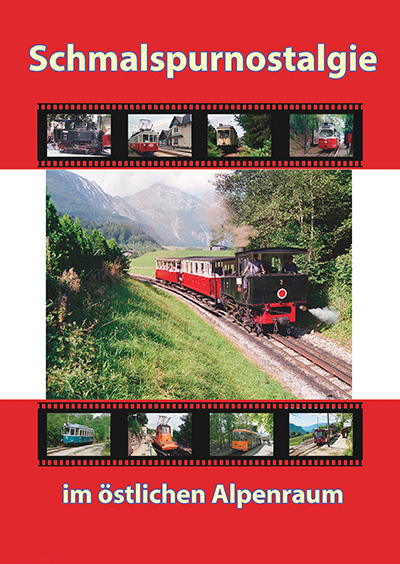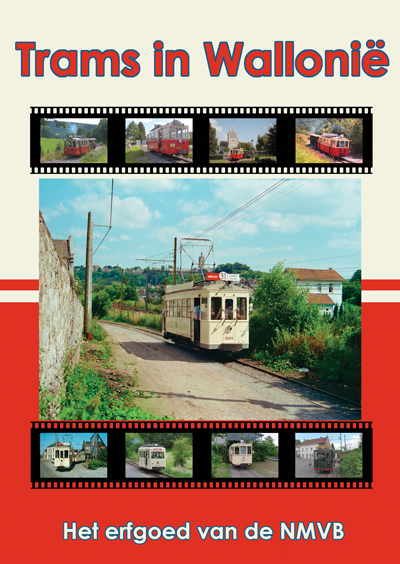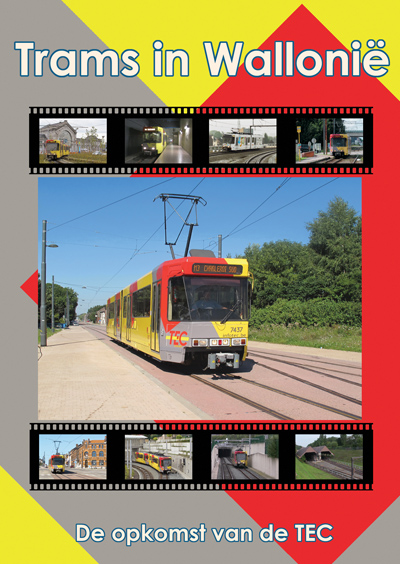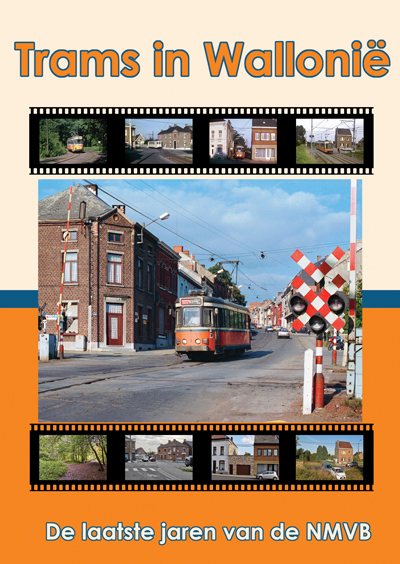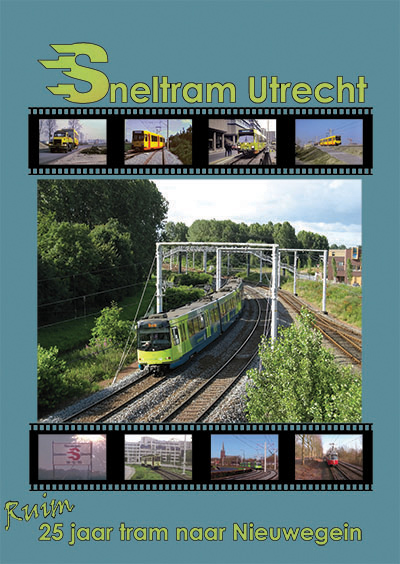Railways and tramways on cine film and video
From raw image to DVD
This page is only interesting for those who want to know how a Super-8 film (or HD video) ends up on DVD. Others I can only recommend to skip to another page as quickly as possible... This is a look at 'my kitchen'. What tools I use for what purpose. Everything can be done differently, and nothing is sacred. It works for me, but that does not mean that there anyone on earth for whom it works equally well. But: if you are interested, try it out. Or contact me for more details than I can mention here!
There are three distinguishable parts to all this:
- Processing of Super-8 movies into computer (video) files,
- Processing of HD video tapes into computer (video) files, and
- Improving video files.
What follows are not technically exhaustive narratives, but rather my experience with the medium. It's more the story of my filming history up to DVD production than a reference book. Anyone who is interested in more details can always contact me.
Super-8 Film
My choice for Super-8 was, at the time, determined both by convenience (a camera with attachable microphone was pleasantly small) and price (when I began a reasonable camera could be purchased really cheaply). The films themselves were dramatically expensive. Anyone who now works with video (at just a few Euros for a one hour tape - or peanuts for reusable cards!) needs to do the maths: a fifteen-meter Super-8 sound film went for about 35 (then) Dutch Guilders. My decision to work at 24 frames per second ('normal' was 18, but I found the quality difference worth it) meant that fifteen meters yielded 2 minutes 45 film. After cutting another ten percent was lost. An hour movie came to over 800 Guilders! And there was always the worry of how much film was already used up if a longer shot came up... It was a lot harder work than it is today!
My film stock came from Kodak, Agfa, Perutz and (just over the German border) Porst. Perutz was Agfa in different packaging, and it was the most affordable. Porst, also, was Agfa and when Perutz was no longer available it was (for a short while) a good alternative. Apart from that I usually used Agfa material, because that obviously mixed well with the other two. Kodak film looks completely different (slightly less contrast, which is often an advantage, less grain and softer colours). But unfortunately, much more expensive - which at that time was deciding me. A few times I used the high-sensitivity film (160 ASA against the normal 40), but the grain was very extreme, and mix with 'normal' film was not so pretty.
My first camera was simple, but did well and kept going for a long time (a Sankyo 420). Then followed a Canon 814 (which was bad), and two Bauers (715) which unfortunately did not last very long. Then came the break until I went digital in 2008.
If these days Super-8 films (or whatever amateur celluloid-based material) end up on a DVD, then it invariably concerns films that are already a finished product. And often they are old or very old, with all the consequences. Movies can be dusty, discoloured, damaged during projection, scratched or moldy. Film splices (wet - that means glued, or dry - that is with adhesive tape) can be a source of misery. Before transferring it to the computer, the film needs to be in the best possible condition.
When the time comes for the films to be transferred on to the computer, there are several methods. My urgent advice is not to give in to false economy at this point. Video cameras in front of attachments with frosted glass projector screens - it can all be done, but there are serious limitations. The worst are that
- there is no synchronisation between the projector and the camera, so there is no 1 to 1 relationship between an image in the film and an image on the computer. Each computer frame is a blend of two adjacent film frames.
- the centre of the image is recorded much brighter than the sides (this is called hot-spot, and it is essentially an extreme case of vignetting).
To do it right, and to prevent putting effort into further processing of films that are not transferred well enough, there is only one method that qualifies: outsourcing. Even then, there are pitfalls. In many cases, firms use frosted glass projection, too, so that does not help. Good results are only obtainable via scanning. And optimal results only with so-called wet-gate scanning. The film passes through a liquid during scanning. This has two effects. Firstly, it is a liquid having the same refractive index as the base material of the film. If the (non-emulsion) side of the film is scratched (visible as cables when projected) those scratches disappear completely. Secondly, the emulsion crystals expand slightly, which reduces scratches on the emulsion side as well.
There will undoubtedly be plenty of companies that perform well. My experience is with Moving Memories in Goor (NL), where utmost care was taken, and where there is room for individual requirements. All of my films were scanned there, and the results were absolutely fine.
Not that the results were well suited for immediate transfer to DVD. Far from it! The complete movies with all the imperfections (stains, discolouration, rocking camera, grain, vibrating images) were made available very faithfully. Who would have thought that 25 year old Agfa film would have become that blue... No, there was a lot of computer-work to be done! More on that after a similar story on video recordings.
HD Video
As with the Super-8 camera, there are many choices to make before the first shot is taken. What resolution is a good choice? (answer: as high as possible, reducing can always be done later). What about the sound - the built-in microphone, an attachable microphone or a separate one? (answer: a question of preference; the Canon HV20 microphone picks up a lot of camera sound, but it is not bad, the attachable Canon microphone is much better, but monaural (in the most convenient position); separate microphones are best, but cost much time to deploy - my choice was the attaching microphone). What camera settings are best? (answer: experiment, experiment and experiment again - and this long before the first serious shot is taken).
Digital video emerged at a time when personal computers were already commonplace. This makes the process of video recording to computer file much easier. Or so you would think. But unfortunately camera manufacturers do not really try to make this easy. The Canon HV20 I used, for example, may have a USB connection, but... that allows only photos to be transferred to the computer. To transfer film clips, the Firewire connection (not USB!) must be used, and only using software that Canon has nothing to do with. A bizarre situation. Fortunately, there is the program HDVsplit, and it does a great job. After using HDVsplit, all film clips are available as separate files on the hard disk. Even that is not the end of the woes. Because they appear in a '.m2t' file type, which almost no program can process. Again the world of free software hobby comes to the rescue: with MPEG StreamClip, m2t-files can easily be converted into '.avi' files, and then we are finally where we need to be. Incidentally, these two processing passes do not involve decoding/encoding, so there is no loss of quality. As was already reported in the Super-8 section, an avi-file is fine for almost all video editing programs.
iMijn latere camera, een Canon G25, was met zijn SD-cards als opslagmedium een stuk handiger in het gebruik. Maar ook die levert vrij exotische filmbestanden af.
Yes, there are numerous pitfalls (avi is really a container for a multitude of different formats), but if the (free) codecs ffdshow and divx are installed, it is very unlikely that this path should not work.
Movie Editing on the Computer
The films are now on the computer, but... there is still a long way to go before there is a product that is worth looking at. Everything depends on the amount of effort that the maker is willing to invest. The technique will not be the issue, because a lot of smaller and larger problems is easily solved, given the right software. The real issue will, in most cases, be: time. Therefore, the following list may be used as inspiration - to pick and choose what is, and what is perhaps less well suited to a particular movie.
The vast majority of techniques are based on two methods. The first is the use of the (free) software packeges VirtualDub (and/or VirtualDubMod, they largely overlap) and AviSynth. VirtualDub(Mod) can read films, subject them to program-controlled operations, and save them afterwards. There are many plug-ins available providing a multitude of features. AviSynth is an incredibly powerful programming language, which requires some learning, but allows operations many professional packages can only dream of. The second is the use of 'normal' photo editing software (such as my favorite Photoshop) in batch mode (recorded 'actions' are run under 'scripts => image processor'), which requires the movie to be split into separate images first.
Titles - A movie is not really finished if there are no titles. Many camcorders offer opportunities, and many scanned films will already have titles. If new titles need to be added, AviSynth offers a good way, as with the 'subtitle' function no desire is left unanswered.
Crop - Both with AviSynth and with a photo editing program, it is possible to zoom in on the original film when desired. That annoying little dog jumping up on the right-hand image edge can simply be removed! Zooming too far has consequences; it costs resolution (pixels) so quite soon, the result looks pixelated.
Perspective - It is a well-known phenomenon. To ensure the entire building is caught in the picture, the camera was slightly lifted, and now it seems to lean backwards. No problem now - through photo editing, processing each image with the same correction, the building stands up straight again. This only backfires when tilts and zooms are present! That remains problematic.
Contrast and Brightness - Together with colour correction the most basic of improvements. With the photo editing software, contrast and brightness can be optimised without much effort. That dark scene in the film is suddenly no longer dark! If half-way through a clip settings need to change, there is no problem. The whole scene is edited once with one setting, and once with another. A very small AviSynth script ensures that the one dissolves beautifully into the other.
Colour Correction - The great enemy of film: shifts in colour temperature. A scene at sunset immediately following after a clip at mid-day, it grates. As with contrast and brightness, this is a breeze with photo editing software. Virtualdub, too, has filters for this job (and there are also plug-ins to get), but I have always found the results with photo editing much better. It's tricky, by the way, if, like me, you are colour blind. All results must checked by someone who does not have that affliction...
Sharpness - A not quite sharp shot can be improved sufficiently to be able to pass quality control. Again, photo editing software is the tool of choice. Usually there are many different ways of sharpening, with endless sets of settings. Experimenting and remaining critical is essential. Generally I have achieved the best results with Unsharp Mask.
Grain/Noise Reduction (1) - Grain (film) and noise (video) may be very different in character, their suppression within VirtualDub/AviSynth is identical. Plug-ins built to counter 'temporal noise' need to be found. This means that frames are compared with a preset number of neighbors, and intelligence behind it looks whether grain or noise caused by defects can be removed. This works amazingly well. Look for plugins with 'depan' in the name.
Grain/Noise Reduction (2) - As an alternative, the photo software can be put to good use. Specially developed plug-ins like Noise Ninja do wonders (although not for free), also in batch mode.
Vignetting - Vignetting is the effect (sometimes deliberately added by artistic directors!) that the image is darker at the edges than in the centre. Again, the photo editing software will help. The non-free (but cheap) package PTLens is a fantastic tool to use.
Black dots, stains and hairs - The older the movie (video does not have this issue), the greater the problem: tiny particles lodged on to the film, repeatedly passing by the incandescent projection lamp, get burned into the image and appear as a hail storm of black dots and hairs. The good news: if the first method of grain/noise reduction is followed, 99.9% of this problem is automatically solved! For the remainder, the photo editing software will need to be started up again, and the worst pieces should be fixed with a 'clone' tool. That usually works best from the previous or next frame.
Image stabilisation (blinking) - This is an effect that frequently causes problems in film. Super-8 film cartridges had a rather nasty design, because the reels were adjacent to eachother. That meant that the film had to be guided in a skewed fashion, and in some cassettes the mechanism was too stiff. If the film transport motor had to work quite hard, it all too soon became a little irregular, with the result that one image was not exposed for exactly the same time as the next. Blinking was the result. I myself had some dramatic cases, which look really not worth keeping. For VirtualDub(Mod) and AviSynth, there is a plug-in called deflicker. The name says it all, and it does its name justice. It may take some research to find the right settings, but once you have them, this form of flickering disappears completely, utterly and totally. A blessing!
Image stabilisation (digital tripod) - Perhaps the most impressive tool of all. All my films were shot freehand. Not because I ever thought this was the best way, but because lugging a tripod along was just too much hassle. The inevitable consequence was that there was always some camera movement (the more zoom, the more severe). And such camera shake can now be removed in a way that really is incredible. It's a plug-in for VirtualDub(Mod) and AviSynth. This one is called deshaker. And for all its brilliance, it is free. A warning is needed. There are many, many settings that can be modified, and finding the right one can be tricky. But if it does not work out, there is a hobbyist behind it to render assistance, with the greatest pleasure, until it works. And once it works... The problem is well-known; suppose there is a telephoto shot of a rock in the distance, made freehand. In the film it looks as if the rock is going up and down and back and forth. What the plugin does is stack all the separate frames on top of one another, so that the rocks are aligned instead of the borders of the frames. The stack then looks irregular, with pictures sticking out. But if the edges are then trimmed, and the pictures are shown as a movie, the rock is suddenly solid as a... rock. The price is that some area is lost near the edges. But there are tricks built in to prevent that as much as possible. This is a brilliant piece of work, and 19 out of 20 shots are easily steadied.
Decabling - This is one of the most difficult forms of damage. In video it does not occur, but in film it is there very frequently: the vertical stripes on the screen that can be so distracting. Especially if they also jump back and forth... A 100% solution for all cases unfortunately does not exist. With a lot of patience, and painstaking labour, often a lot of improvement is possible (with a photo editing package like Photoshop, 'content aware fill' is a good option if the cable can be trapped in a tiny selection). Unfortunately the result, despite all the hard work, is sometimes even more difficult to stomach than the original. This remains a worry. All the more reason for wet-gate scanning, which removes a lot of these problems at the source!
Commentary - Certainly documentaries, my genre, can not do without commentary. There are a few requirements, but everything I mention here has nothing to do with improving films - unless comments are re-done. What is needed? A good running text with correct grammar, which, spoken at a normal pace, is exactly adjusted to the images. A good speaking voice. And a speaker who does not stumble over the text. If the text does not suit the speaker, the text needs to change. A quiet space, with absolutely no ambient sounds, for text recording. Proper recording equipment, and the ability to transfer the recording to the computer. Recording directly on to the computer is also possible - there is ample (free) software to do that.
Sound Mix - Mixing music, live sound and commentary together used to be, in analogue times, quite a big job. Nowadays it is a snap to adjust sound levels, make fades, suppress noise, stretch or shrink playing time without changing the pitch - you name it. A must: the free package Audacity, which does all of this remarkably well. To recombine picture and sound, VirtualDub(Mod) and AviSynth are once more top recommendations.
DVD structures - If only a DVD were but a collection of AVI files on a disc. The reality is much more complicated, and exporting movies to DVD structures (possibly including menus) absolutely requires a so-called authoring program. In this case I have not chosen a free solution, but a product that works very comfortably: TMPGenc Authoring Works. It does almost everything I want.
DVD multiplication - If the print run of the DVD threatens to be more than roughly a dozen copies, it may already be worth scouring the internet looking for companies that offer a multiplication service. Upwards of some 500 pieces, real pressed DVDs can already be genuinely interesting; for smaller numbers, the DVD-R should be chosen. With cover, 4-page printed booklet, outside label and DVD label, including burning and packaging in cellophane, they need not cost as much as three Euros apiece. At such prices, all the trouble of doing it yourself is really too much, especially if, when done by a serious firm, it looks much more professional as well!
Finally, there are a few important warnings to give out. It is important to find the optimal sequence of all the steps that are taken. A wrong order can greatly affect the quality of the final film. And it is also very important that as many steps as possible are executed in combination, at one time. Each time a jpg-file is written, there will be a (substantial) loss of quality. And each time a video clip is processed by an encoder, the same thing occurs. So that should be minimised, or alternatively, lossless formats could be used (tiff instead of jpg, and uncompressed video). A few extra hard disks will come in handy!
